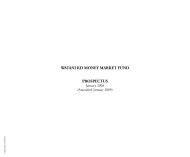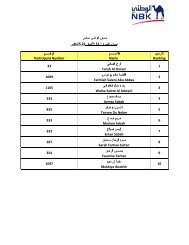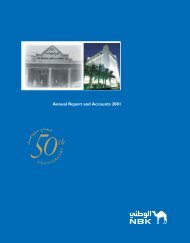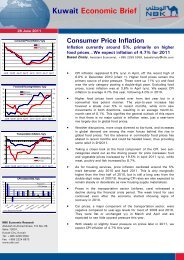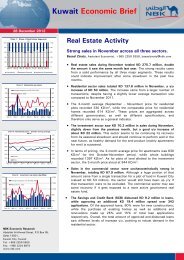Consolidated Financial Statements and Independent Auditors' Report
Consolidated Financial Statements and Independent Auditors' Report
Consolidated Financial Statements and Independent Auditors' Report
Create successful ePaper yourself
Turn your PDF publications into a flip-book with our unique Google optimized e-Paper software.
Notes to the <strong>Consolidated</strong> <strong>Financial</strong> <strong>Statements</strong><br />
31 December 2010<br />
2 SIGNIFICANT ACCOUNTING POLICIES (continued)<br />
2.23 Business combinations <strong>and</strong> goodwill<br />
Business combinations are accounted for using the acquisition method of accounting. This involves recognising identifiable<br />
assets (including previously unrecognised intangible assets) <strong>and</strong> liabilities of the acquired business at fair value. Any excess<br />
of the cost of acquisition over the fair values of the identifiable net assets acquired is recognised as goodwill. If the cost<br />
of acquisition is less than the fair values of the identifiable net assets acquired, the discount on acquisition is recognised<br />
directly in the consolidated statement of income in the year of acquisition. Subsequent transactions with non-controlling<br />
interest without change in control will be recorded only in equity <strong>and</strong> will not result in any change in goodwill. Goodwill<br />
acquired in a business combination is initially measured at cost, being the excess of the cost of the business combination<br />
over the net fair value of the identifiable assets <strong>and</strong> liabilities acquired. Following initial recognition, goodwill is measured at<br />
cost less any accumulated impairment losses. Goodwill is reviewed for impairment, annually or more frequently if events or<br />
changes in circumstances indicate that the carrying value may be impaired. Goodwill is recorded in the functional currency<br />
of the foreign operation <strong>and</strong> is translated to the presentation currency at the rate of exchange prevailing at the statement<br />
of financial position date. When subsidiaries are sold, the difference between the selling price <strong>and</strong> the net assets plus<br />
cumulative translation differences <strong>and</strong> goodwill is recognised in the consolidated statement of income.<br />
2.24 Intangible assets<br />
Intangible assets comprise separately identifiable intangible items arising from business combinations. An intangible<br />
asset is recognised only when its cost can be measured reliably <strong>and</strong> it is probable that the expected future economic<br />
benefit will flow to the Group. Intangible assets are initially measured at cost. The cost of intangible assets acquired<br />
in a business combination is their fair value as at the date of acquisition. Following initial recognition, intangible assets<br />
are carried at cost less any accumulated amortisation <strong>and</strong> any accumulated impairment losses. The useful lives of<br />
the intangible assets are assessed to be either finite or indefinite. Intangible assets with finite lives are amortised on<br />
a straight line basis over the useful economic life of 5 to 12 years <strong>and</strong> tested for impairment whenever there is an<br />
indication that the intangible asset may be impaired. Intangible assets with indefinite useful lives are not amortised<br />
but tested for impairment annually <strong>and</strong> whenever there is an indication that the intangible asset may be impaired.<br />
If the carrying value of the intangible asset is more than the recoverable amount, the intangible asset is considered<br />
impaired <strong>and</strong> is written down to its recoverable amount. The excess of carrying value over the recoverable amount is<br />
recognised in the consolidated statement of income.<br />
Impairment losses on intangible assets recognised in the consolidated statement of income in previous periods, are<br />
reversed when there is an increase in the recoverable amount.<br />
2.25 Due to Banks <strong>and</strong> <strong>Financial</strong> Institutions & Customer deposits<br />
Due to Banks <strong>and</strong> <strong>Financial</strong> Institutions & Customer Deposits are stated at amortised cost using effective interest<br />
method. The carrying values of such liabilities which are being effectively hedged for changes in fair value are adjusted<br />
to the extent of the changes in fair value being hedged.<br />
2.26 <strong>Financial</strong> guarantees<br />
In the ordinary course of business, the Group gives financial guarantees, consisting of letters of credit, guarantees <strong>and</strong><br />
acceptances. <strong>Financial</strong> guarantees are initially recognised in the consolidated financial statements at fair value, being the<br />
premium received, in other liabilities. The premium received is recognised in the consolidated statement of income in ‘net<br />
fees <strong>and</strong> commissions’ on a straight line basis over the life of the guarantee. The guarantee liability is subsequently carried<br />
at initial measurement less amortisation. When a payment under the guarantee is likely to become payable, the present<br />
value of the expected payments less the unamortised premium is charged to the consolidated statement of income.<br />
2.27 Treasury shares<br />
The Bank’s holding of its own shares are accounted for as treasury shares <strong>and</strong> are stated at purchase consideration<br />
including directly attributable costs. When the treasury shares are sold, gains are credited to a separate account in<br />
equity (treasury share reserve) which is non distributable. Any realised losses are charged to the same account to the<br />
extent of the credit balance on that account. Any excess losses are charged to retained earnings then to reserves.<br />
Gains realised subsequently on the sale of treasury shares are first used to offset any previously recorded losses in<br />
the order of reserves, retained earnings <strong>and</strong> the treasury share reserve amount. No cash dividends are distributed<br />
on these shares. The issue of bonus shares increases the number of shares proportionately <strong>and</strong> reduces the average<br />
cost per share without affecting the total cost of treasury shares.<br />
2.28 Fiduciary assets<br />
Assets <strong>and</strong> related deposits held in trust or in a fiduciary capacity are not treated as assets or liabilities of the Group<br />
<strong>and</strong> accordingly are not included in the consolidated statement of financial position.<br />
2.29 Significant accounting judgements <strong>and</strong> estimates<br />
In the process of applying the Group’s accounting policies, management has used judgements <strong>and</strong> made estimates in<br />
determining the amounts recognised in the consolidated financial statements. The most significant use of judgements<br />
<strong>and</strong> estimates are as follows:<br />
Accounting judgements<br />
Impairment of investments<br />
The Group treats available for sale equity investments as impaired when there has been a significant or prolonged<br />
decline in the fair value below its cost. The determination of what is significant or prolonged requires significant<br />
judgement. In addition, the Group also evaluates among other factors, normal volatility in the share price for quoted<br />
investments, the future cash flows <strong>and</strong> discount factors for unquoted investments.<br />
Estimates<br />
The key assumptions concerning estimates made at the statement of financial position date, which have a significant<br />
risk of causing a material adjustment to the carrying amounts of financial assets <strong>and</strong> liabilities are discussed below:<br />
Impairment losses on loans <strong>and</strong> advances <strong>and</strong> investments in debt instruments<br />
The Group reviews problem loans <strong>and</strong> advances <strong>and</strong> investments in debt instruments on a quarterly basis to assess<br />
whether a provision for impairment should be recorded in the consolidated statement of income. In particular,<br />
considerable judgement by management is required in the estimation of the amount <strong>and</strong> timing of future cash flows<br />
when determining the level of provisions required. Such estimates are necessarily based on assumptions about<br />
several factors involving varying degrees of judgement <strong>and</strong> uncertainty <strong>and</strong> actual results may differ, resulting in<br />
future changes to such provisions.<br />
Valuation of unquoted investments<br />
Valuation of unquoted investments is normally based on one of the following:<br />
• the expected cash flows discounted at current rates applicable for items with similar terms <strong>and</strong> risk characteristics;<br />
• recent arm’s length market transactions;<br />
• current fair value of another instrument that is substantially the same;<br />
• valuation models.<br />
The determination of cash flows <strong>and</strong> discount factors for unquoted investments requires significant estimation.<br />
2.30 Basis of translation<br />
The United States dollar amounts in the consolidated statement of income, consolidated statement of comprehensive income,<br />
consolidated statement of financial position <strong>and</strong> consolidated statement of cash flows represent supplementary information<br />
<strong>and</strong> have been translated at a rate of KD 0.2806 per USD which represents the mid-market rate at 31 December 2010.<br />
3 SEGMENTAL ANALYSIS<br />
The Group organises <strong>and</strong> manages its operations by geographic territory in the first instance, primarily Domestic <strong>and</strong><br />
International. Within its domestic operations, the Group segments its business into Consumer Banking, Corporate<br />
Banking, Investment Banking <strong>and</strong> Asset Management <strong>and</strong> Group Centre. All operations outside Kuwait are classified<br />
as International. Management treats the operations of these segments separately for the purposes of decision making,<br />
resource allocation <strong>and</strong> performance assessment.<br />
Consumer Banking<br />
Consumer Banking provides a diversified range of products <strong>and</strong> services to individuals. The range includes consumer<br />
loans, credit cards, deposits, foreign exchange <strong>and</strong> other branch related services. This business segment also<br />
comprises Private Banking. Private Banking provides a comprehensive range of customised <strong>and</strong> innovative banking<br />
services to high net worth individuals <strong>and</strong> to institutional clients.<br />
Corporate Banking<br />
Corporate Banking provides a comprehensive product <strong>and</strong> service offering to business <strong>and</strong> corporate customers,<br />
including lending, deposits, trade finance, foreign exchange <strong>and</strong> advisory services.<br />
Investment Banking <strong>and</strong> Asset Management<br />
Investment Banking provides a full range of capital market advisory <strong>and</strong> execution services. The activities of Asset<br />
Management include wealth management, asset management, custody, brokerage <strong>and</strong> research.<br />
64 National Bank of Kuwait - Annual <strong>Report</strong> 2010 65










